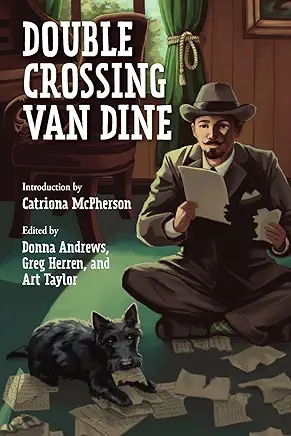Thanks once again to Oline Cogdill for two reviews. In the South Florida Sun Sentinel, she discusses Fog and Fury by Rachel Howzell Hall and also the anthology, Double Crossing Van Dine. You can order the books through The Poisoned Pen’s Webstore. https://store.poisonedpen.com/
Book review: ‘Fog and Fury’ about small beach town has realistic characters, brisk plot
Plus, smart ‘Double Crossing Van Dine’ anthology breaks all the rules of detective fiction.
‘Fog and Fury: A Haven Thriller’ by Rachel Howzell Hall; Thomas & Mercer; 395 pages; $28.99
The fog that seems to permeate the small, supposedly peaceful Haven, California, tends to mask the fury that seeps throughout the beach town as new resident Alyson “Sonny” Rush arrives in Rachel Howzell Hall’s aptly titled “Fog and Fury.”
Despite Haven’s nickname of “Mayberry by the Sea,” Sonny is often “blinded” by the persistent fog every morning. The fog, she says, “muffled sound … obscured sight … made the familiar feel foreign.” Haven “ain’t what it seems,” she’s warned about this town of 1,000. People do “bad” things.
Yet Sonny leaves the LAPD after a decade to move to this Northern California town to work as a private investigator for her godfather, Ivan Poole, who also is a former police detective. Sonny and her mother, who has the beginnings of dementia, are among the few Black residents.
Sonny learns immediately how duplicitous Haven can be when her first case involves the family of wealthy Cooper Sutton, her ex-lover who had told her he was divorced. (He isn’t.) He said he would move to Los Angeles. (He wasn’t planning to.) He’s too invested in his career as a real estate developer. He wants to make Haven more attractive to investors.
Sonny’s first case is finding Figgy, a goldendoodle owned by London and Mackenzie, Cooper’s wife and daughter. Mackenzie claims the dog was stolen, but Ivan believes she has hidden the dog to get attention. The dog is safe. But the Sutton family is a toxic mess. Sonny also is hired by the parents of Xander Monroe, a star student and athlete whose recent death was ruled a suicide. The parents refuse to believe Xander killed himself and they distrust what appears to be an incompetent police investigation.
Sonny’s investigations lead to a complex network of corruption, betrayal and lies infesting Haven. Howzell Hall elevates “Fog and Fury” with realistic characters who lead a brisk plot. She infuses her novels with bits of passive racism that hit hard. Haven is so small, and has so few Black residents, that none of the stores stock Black hair care products.
“Fog and Fury” launches a new series for Howzell Hall, whose last several novels have been stand-alones. A trip back to Haven would be welcomed.
Short stories anthology
‘Double Crossing Van Dine,’ edited by Donna Andrews, Greg Herren and Art Taylor; introduction by Catriona McPherson; Crippen & Landru; 310 pages; $22
The Golden Age of Detective Fiction that launched the classic genre novel is considered to be from the 1920s to 1930s. But contemporary readers know that a second Golden Age began in the mid-1980s when the novels became more emotionally involving along with the introduction of detectives from myriad backgrounds and cultures. The genre continues to evolve, seeing several golden ages in the past decades.
Going out on a limb here, many authors from the ’20s and ’30s haven’t survived the test of time, aside from a few, such as Agatha Christie. And going out on another limb here, S.S. Van Dine, the focus of this short story anthology, probably is among those only recognized by readers steeped in the history of mystery fiction.
Van Dine, whose real name was Willard Huntington Wright, was an American art critic, literary editor, biographer and author who wrote the series about detective Philo Vance.
He also penned the “Twenty Rules for Writing Detective Fiction.” The 20 clever short stories in this smart anthology each aims to ignore them, or “break them like kindling,” as author Catriona McPherson writes in her introduction. Crime fiction has been richer when writers discarded these rather fatuous and often useless rules and set their own paths, as the authors of these short stories show.
Each story begins describing one of Van Dine’s rules, then crushing it.
Fort Lauderdale author Elaine Viets’ “Sweet Poison,” about two young women struggling in New York’s Lower East Side during 1921, forgets the rule that “all clues must be publicly stated,” as they deal with the unexpected death of one’s “Wall Street sugar daddy.”
Barb Goffman puts aside the “no love interest” rule in “Baby Love” as a fledgling-but-broke private detective tries to launch his career so he and his very loving wife can afford a baby. Co-editor Greg Herren stifles the “no supernatural” rule with “The Spirit Tree,” in which the solution to a murder comes from beyond. The “only one detective rule” doesn’t work for Delia Pitts’ “Better Together,” which finds two heads are better than one.
Boca Raton author Alan Orloff’s “The Society Set” takes a butler who has several jobs for his persnickety employer on a journey of a jewelry heist that actually embraces Van Dine’s version of a “fascinating crime.” Leigh Perry has a work-around for the “no secret societies” ban in “Guilted Lily,” in which a tight-knit group of grifters seek a score.
Tom Mead dismisses the rule that servants should never be the culprits in “The Tell-Tale Thumb.” Some people, Mead writes, see only the uniform, not the person who hides in plain sight.
The majority of the authors in “Double Crossing Van Dine” have either won or been nominated for awards. A handy brief bio of each of the authors may inspire readers to seek out more of their stories.


